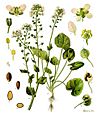Cochlearia officinalis facts for kids
Quick facts for kids Cochlearia officinalis |
|
|---|---|
 |
|
| Scientific classification | |
| Genus: |
Cochlearia
|
| Species: |
officinalis
|
Cochlearia officinalis, also known as common scurvygrass or spoonwort, is a type of flowering plant. It belongs to the Cochlearia group in the Brassicaceae family. This plant got its name because people noticed it could cure scurvy. Sailors used to take it on long voyages, either dried or as a liquid extract.
Scurvygrass has a very bitter taste. People often mixed it with other herbs and spices to make it taste better. Even with its strong flavor, drinks and sandwiches made with scurvygrass became quite popular in the UK. This trend lasted until the mid-1800s, when citrus fruits like oranges and lemons became easier to find.
Contents
What Does Scurvygrass Look Like?
Scurvygrass is a plant that can live for two years (biennial) or many years (perennial). It usually grows to be about 10 to 50 centimeters (4 to 20 inches) tall. Its stems are smooth and have long stalks with thick, fleshy leaves.
The leaves near the bottom of the plant are shaped like a heart or a kidney. They form a circle, or rosette, around the base. Scurvygrass flowers from May to August. The small flowers are white or light purple. They have four petals, like a daisy.
The seeds of the plant become ready from July to September. They are small, round, and reddish-brown. The flowers can pollinate themselves. They are also pollinated by insects like bees, flies, and beetles. This plant is known to attract wildlife and can handle cold weather well.
Naming Scurvygrass
This plant is commonly called 'common scurvy-grass', 'scurvy-grass', or 'spoonwort'.
A famous Swedish botanist named Carl Linnaeus first officially described this plant in 1753. He wrote about it in his important book, 'Species Plantarum'.
The second part of its scientific name, officinalis, means that the plant has a known use. This could be for medicine, cooking, or other purposes.
There is one known type of scurvygrass that is a bit different. It is called Cochlearia officinalis subsp. integrifolia.
Where Does Scurvygrass Grow?

Scurvygrass is originally from Europe, where the weather is mild.
Where Can You Find It?
You can find scurvygrass in many parts of Europe.
- In Eastern Europe, it grows in parts of Russia, like Arkhangelsk, Komi, Murmansk, and Nenets.
- In Middle Europe, it's found in Belgium, Germany, Netherlands, and Switzerland.
- In Northern Europe, it grows in Iceland, Denmark, the Faroe Islands, Finland, Ireland, Norway, Sweden, and the United Kingdom.
- In Southwestern Europe, it is found in France.
Scurvygrass has also started growing naturally in other European countries, such as Italy and Spain.
What Kind of Places Does It Like?
This plant likes to grow in coastal areas and mountains in Europe, including the Alps. In Ireland, it prefers saltmarshes, rocky cliffs by the sea, and muddy seashores. In northern Scandinavia, it grows on gravel beaches, in cracks in beach cliffs, and in salt marshes.
How Was Scurvygrass Used?
Long ago, herbalists used scurvygrass to treat scurvy. This is because the plant contains Vitamin C, which helps prevent scurvy.
A famous herbalist named Nicholas Culpeper wrote about scurvygrass in his book, 'Complete Herbal'. He said it was very good for people with scurvy. He also believed it helped clean the blood, liver, and spleen. He suggested drinking its juice every morning in the spring.
The leaves of scurvygrass were also used to make a drink called scurvygrass ale. This special beer has been made again sometimes as a craft ale.
Images for kids
See also
 In Spanish: Cochlearia officinalis para niños
In Spanish: Cochlearia officinalis para niños



